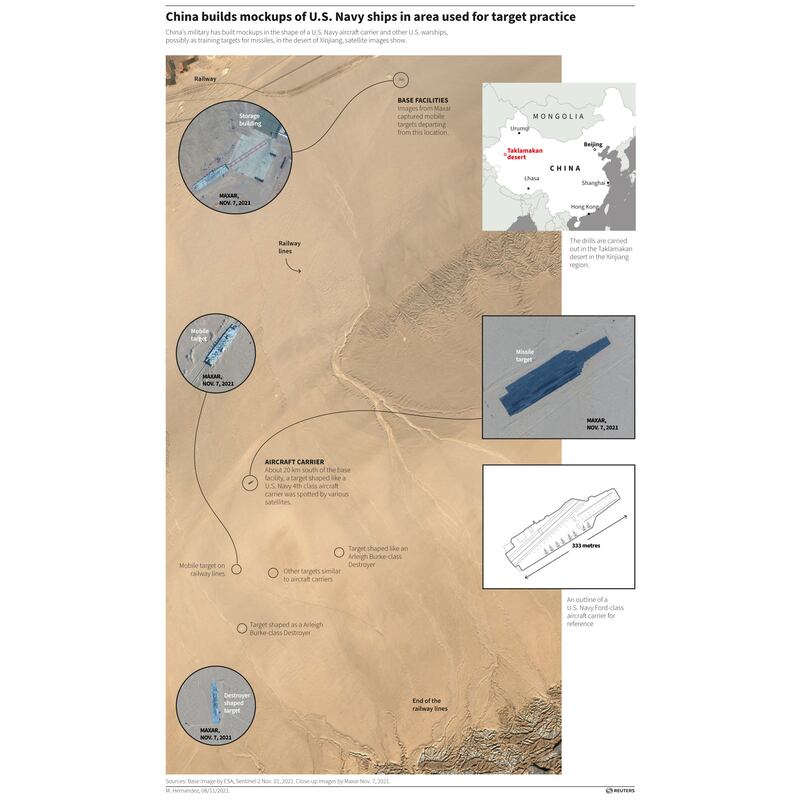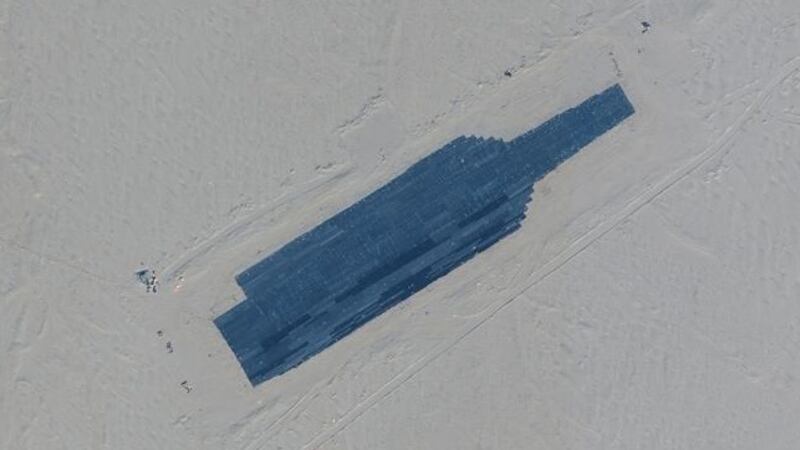The reported building of an aircraft carrier-shaped missile target range in China’s Xinjiang region can be seen as a thinly veiled message of deterrence to Taiwan and its ally the United States, a respected security analyst said.
China has denied any knowledge of the development of missile targets in the shape of U.S. military ships, as revealed by the U.S. space technology and intelligence company Maxar.
But in an interview with RFA, John Blaxland, professor of International Security and Intelligence Studies at the Strategic and Defense Studies Centre at the Australian National University, said this latest satellite discovery may have been deliberate on China’s part in order to send a message to both the U.S. and Taiwan.
Satellite imagery captured in October but only released by Maxar Technologies on Sunday showed structures that looked like a full-scale aircraft carrier and at least two other warships in the Taklamakan desert in Xinjiang, northwest China.
The images led to suggestions that the mock-ups may be used as training targets for Chinese anti-ship ballistic missiles (ASBMs) in the case of naval clashes with the U.S. However when asked about them on Monday, China’s Foreign Ministry Spokesperson Wang Wenbin said he was “not aware of the situation.”

China has been developing ASBM systems in recent years amid growing tension in the waters around it including the South China Sea and across the Taiwan Strait.
“China must have known that the United States would be in the position to monitor through satellites significant developments on the ground,” Blaxland said, adding: “They know it [the range] will be discovered.”
“And they’re quite happy to send signals through that to the U.S. about their preparedness to confront, attack and destroy American aircraft carriers that have been dominant military platforms that enable the U.S. to project power globally in a way unchallenged since 1945.”
USNI News, a news portal specializing in the U.S. Navy, said that what it calls the target range includes the full-scale outline of a U.S. carrier and at least two Arleigh Burke-class destroyers. It says the facility also has “an extensive rail system.”
It notes that an Oct. 9 image from Maxar shows a 75 meter-long target with extensive instrumentation on a 6 meter-wide rail that helps it move and enables target acquisition testing.
“This new range shows that China continues to focus on anti-carrier capabilities, with an emphasis on U.S. Navy warships,” USNI News said.
Blaxland said the development of the range “seems quite an elaborate effort” as it is costly to build such full-scale moving mock-ups.
“I would have thought they’d be able to simulate with computer-generated systems without having to go to such extreme but it’s always good to test the systems out on a large target like a moving simulated aircraft carrier in the desert,” he said.
“Furthermore, China probably feels that money is no object when it comes to sending messages about challenging America’s naval dominance in the Western Pacific.”

Satellite image provided by Maxar Technologies shows a carrier-shaped designated area in Ruoqiang county, China, Wednesday, Oct. 20, 2021. [Maxar Technologies via AP]
Cross-Strait tensions
The news of the target range comes as cross-Strait tensions have intensified in recent months.
In the first five days of October, Taiwan reported around 150 incursions of Chinese fighter jets, bombers and other military aircraft into its Air Defense Identification Zone (ADIZ). Taiwan’s defense minister Chiu Kuo-cheng on Oct. 6 admitted that tensions with China were “at their worst in 40 years.”
Just last Saturday, Taiwan's Ministry of National Defense said 16 Chinese fighter jets had entered its ADIZ.
The building of the new target range may also be part of the display of China’s military might in order to “ratchet up intimidation towards Taiwan,” according to Blaxland.
“It will be sending a very loud signal to the United States that if it wants to stay in the game and remain a prominent and pre-eminent power in East Asia in support of its allies, it will need to take a considerably different approach and muscle up,” he said.
China has been developing several anti-ship ballistic missile programs. The latest Department of Defense’s annual report on China’s military suggests that in July 2019, the Chinese military “conducted its first-ever confirmed live-fire launch into the South China Sea, firing six DF-21D anti-ship ballistic missiles (ASBMs) into the waters north of the Spratly Islands.”
At the same time, the People’s Liberation Army is seeking to develop a longer range land-based ASBM, the DF-26, as well as anti-ship missiles that can be fired from aircraft and warships.
“Quantitatively, the U.S. now has been well eclipsed (by China) in East Asia, so it needs to build its conventional military capabilities,” said Blaxland.
“But there’s a significant knock-on effect for U.S. allies as well and that’s one of the reasons why Australia is now on a more urgent basis pressing to build its military capabilities and acquire nuclear-propulsion submarines.”
